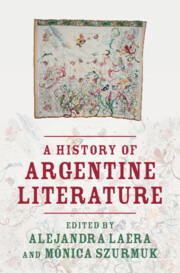Book contents
- A History of Argentine Literature
- A History of Argentine Literature
- Copyright page
- Contents
- Figures
- Contributors
- Editors’ Acknowledgments
- Introduction
- Part I Literary Dates
- Chapter 1 1536: The Creation of a Literary Space
- Chapter 2 1810: Patriotic Voices
- Chapter 3 1837: The Foundation of a National Literature
- Chapter 4 1884: A Literary Field in Formation
- Chapter 5 1910: A Modern Lettered City
- Chapter 6 1926: Traditions Old and New
- Chapter 7 1948: Culture and the State
- Chapter 8 1963: Experimentation and the Common Reader
- Chapter 9 1980: Memory and the Novel
- Chapter 10 2001: Argentine Narrative in the New Millennium
- Part II Critical Inroads
- Part III Literary Names
- Index
- References
Chapter 1 - 1536: The Creation of a Literary Space
from Part I - Literary Dates
Published online by Cambridge University Press: 09 May 2024
- A History of Argentine Literature
- A History of Argentine Literature
- Copyright page
- Contents
- Figures
- Contributors
- Editors’ Acknowledgments
- Introduction
- Part I Literary Dates
- Chapter 1 1536: The Creation of a Literary Space
- Chapter 2 1810: Patriotic Voices
- Chapter 3 1837: The Foundation of a National Literature
- Chapter 4 1884: A Literary Field in Formation
- Chapter 5 1910: A Modern Lettered City
- Chapter 6 1926: Traditions Old and New
- Chapter 7 1948: Culture and the State
- Chapter 8 1963: Experimentation and the Common Reader
- Chapter 9 1980: Memory and the Novel
- Chapter 10 2001: Argentine Narrative in the New Millennium
- Part II Critical Inroads
- Part III Literary Names
- Index
- References
Summary
This chapter analyzes the colonial period, taking 1536, the date of the founding of the city of Buenos Aires, as a starting point. It aims to discuss texts linked to the conquest of the River Plate – namely, Álvar Núñez Cabeza de Vaca’s Comentarios (1555), Ulrich Schmidl’s Derrotero y viaje a España y las Indias (1567), and Ruy Díaz de Guzmán’s Argentina (1612), among other letters, chronicles, and documents – using water, a key aspect of the spatiality constructed in these works, as a guiding axis for the analysis. This is not aesthetized water, waiting for a contemplative gaze, but water marked by overflow, excessive, water that stagnates, sickens, and stings, overcoming boundaries and impeding the actions of the body attempting to own those lands. In the colonial period, particularly in the texts discussed, a water matrix takes shape which will become the seed of fiction in Argentine literature. The presence of water not as a background or the setting for major events, but as a founding incident of narration, as the main driver of action; a presence which renders spatiality and the bodies traversing it (and enduring it) the keys to the narrative of the River Plate.
- Type
- Chapter
- Information
- A History of Argentine Literature , pp. 11 - 23Publisher: Cambridge University PressPrint publication year: 2024

